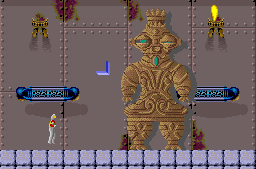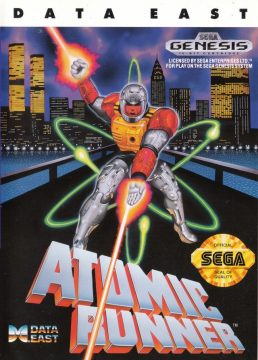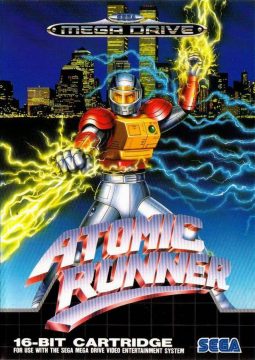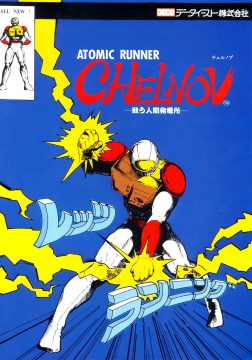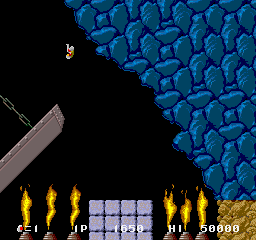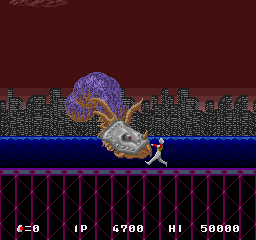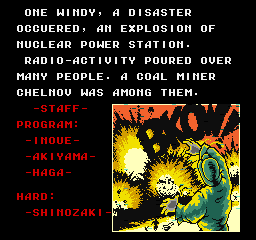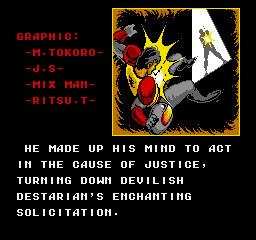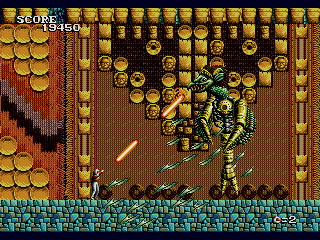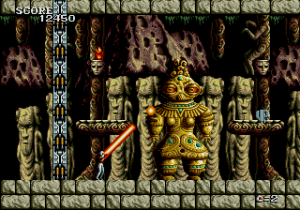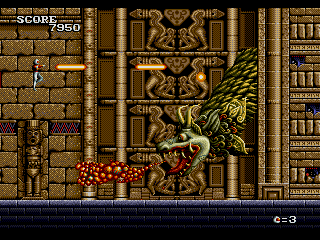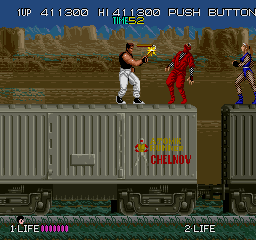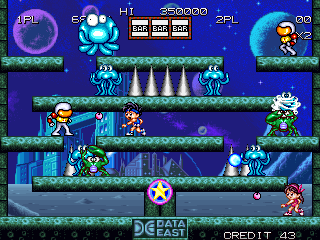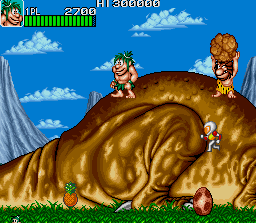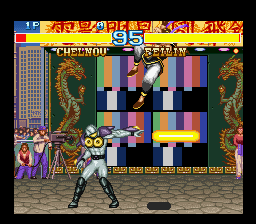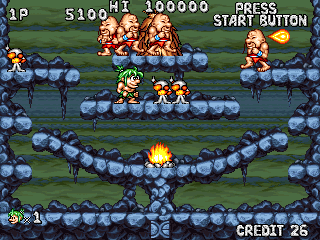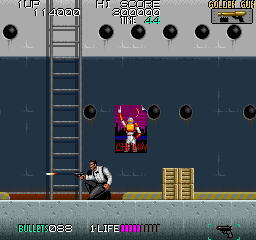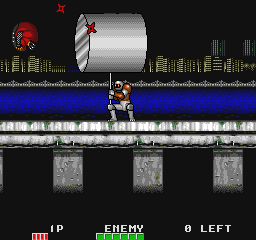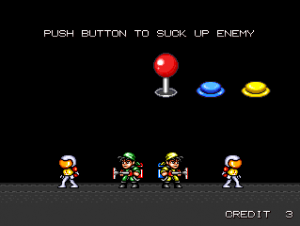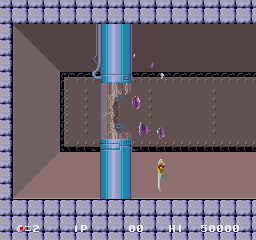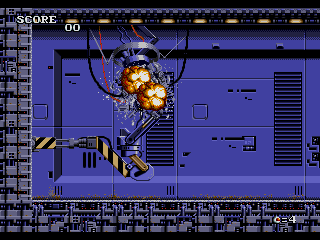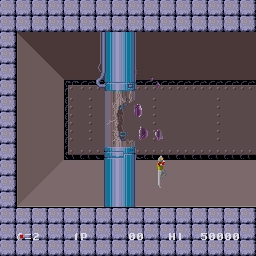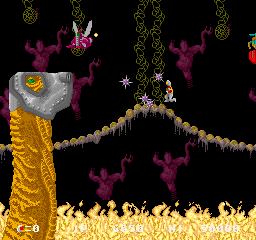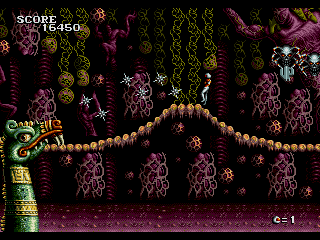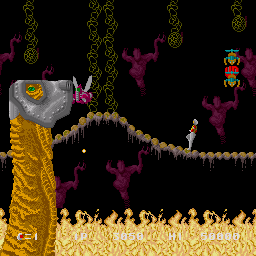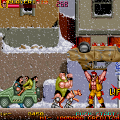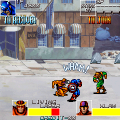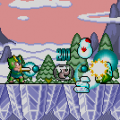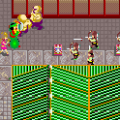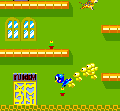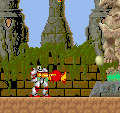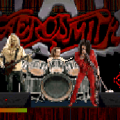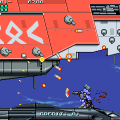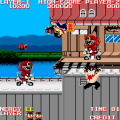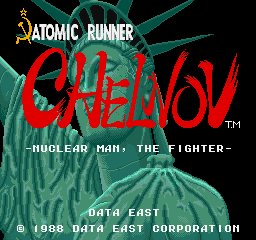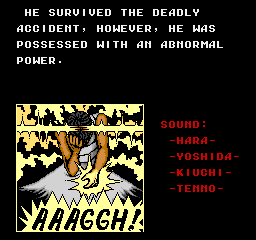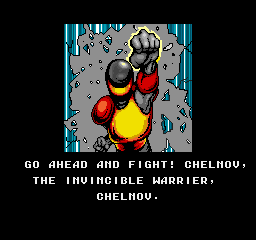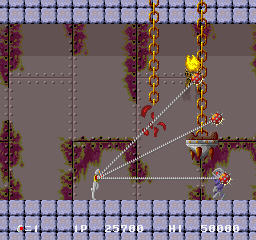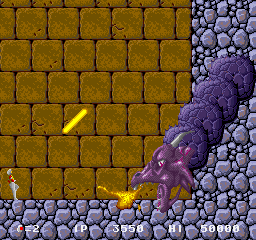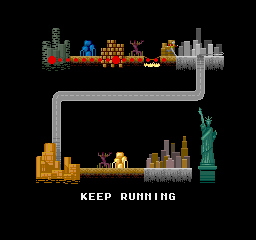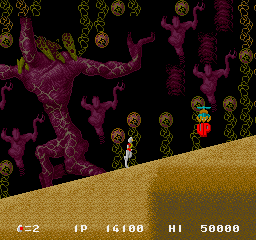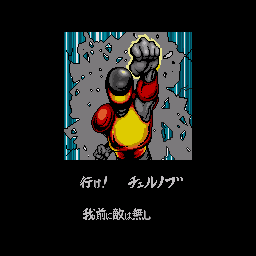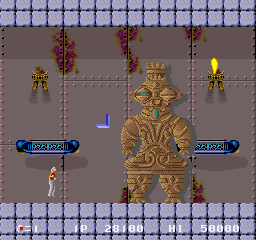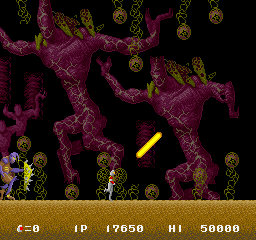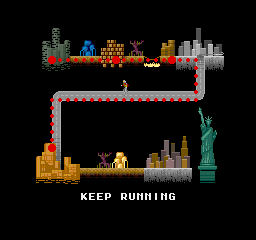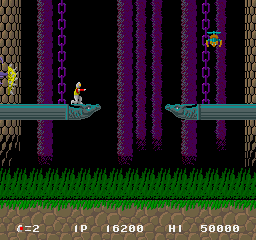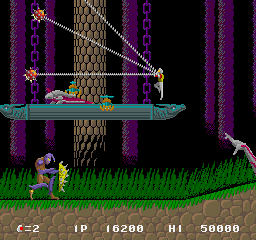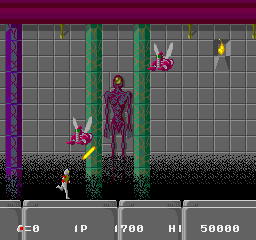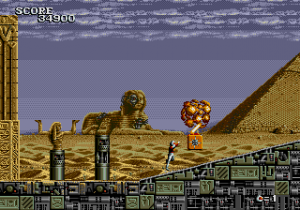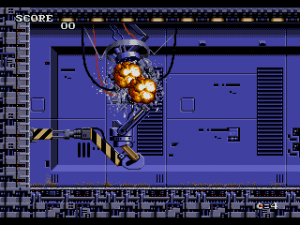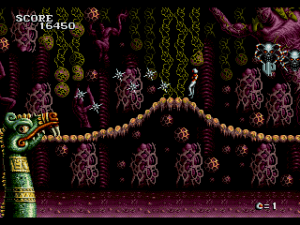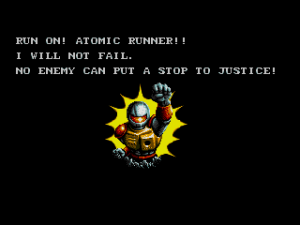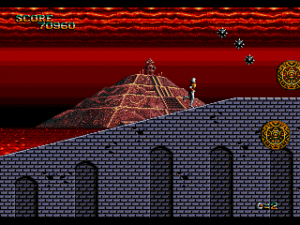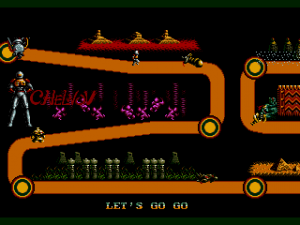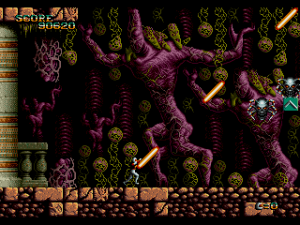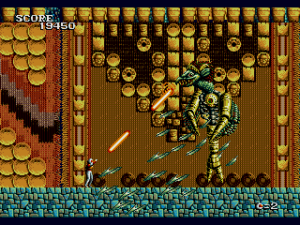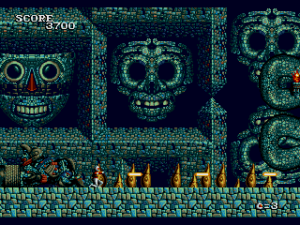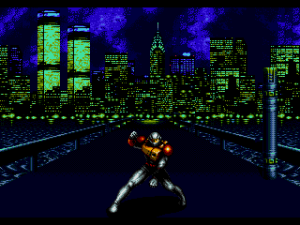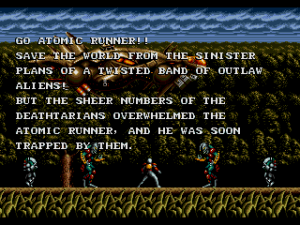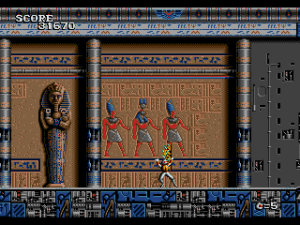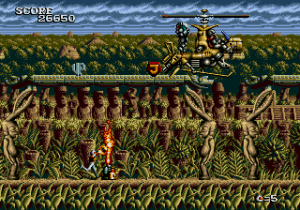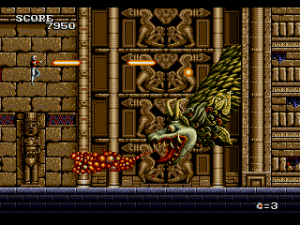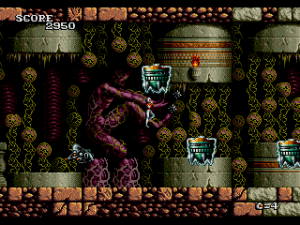Atomic Runner Chelnov, like many of Data East’s titles, is one of those games that’s regarded as a cult classic in Japan despite being largely forgotten by the rest of the world. The series never really took off anyway, as it was not released on consoles until four years after its arcade debut. The game offers nice animation, an intense challenge, and some outlandish graphics. However, arcade games with much larger character sprites than anything in Chelnov had become the standard very shortly after its release, making it seem more primitive than it actually is. While Data East read the tea leaves correctly in making a game about a superhero in a robotic suit so close to the release of RoboCop (as a complement to the way Bad Dudes successfully evokes cheeseball 80s martial arts films like Enter the Ninja and Ninja: American Warrior), the game’s high challenge and tiny sprite for the main character held back its potential popularity.
At a glance, Chelnov looks like a typical side view shooter like Contra or Gunforce, but Data East actually created something completely unique with the game’s structure and pacing. For starters, the screen never stops scrolling, making it easy to miss vital items that improve Chelnov’s abilities. Despite the constant forward momentum, enemies will still approach Chelnov from the left side of the screen. To help keep pace, Chelnov runs forward automatically, you have to actually hold the joystick back just to stand still. Chelnov can also jump very high, and this height can be increased even more by picking up a power-up item. Besides shooting a variety of weapons at foes, he can also defeat them by jumping on them, and can even bounce off of stronger enemies to avoid their attacks. None of these abilities are wasted, as the speed at which the screen scrolls, combined with the enemies constantly coming at you, requires some intense maneuvering to survive. Chelnov also always faces right by default, with the player having to press a button just to turn around. This seems awkward at first, but the game is built around it, requiring Chelnov to shoot in any direction while still moving forward at all times.
All of the enemy placements are pre-designed, so while it can be brutal at times, it also gives players a chance to try different tactics depending on what power-ups they’ve acquired throughout the level. Those boosts are plentiful, and all of the game’s weapons are very useful, even the laser gun he starts the game with. The game also poses several impressive platforming challenges that take advantage of his ability to bounce off of enemies. There are several instances where there is no ground to walk on, only a series of foes Chelnov must jump off of to avoid falling to his death. It’s put to especially great use in the last level, where Chelnov makes the final push to the Statue of Liberty by repeatedly bouncing off of an armored orange dinosaur encountered earlier in the game.
At the same time, the game’s visual weirdness and simple-but-catchy music is a great indicator of Data East’s identity as a publisher. Several of the company’s regulars came together on this game, notably Azusa Hara, Takaaki Inoue, and Tatsuya Kiuchi. Azusa Hara’s music in Atomic Runner Chelnov is lighthearted, while still lending an air of urgency to the game. Data East’s music would be composed via a collaboration between two or three composers, who would then often take on other projects or leave for other companies. Azusa Hara was a regular with Data East, however, and is the one most responsible for the music in their arcade games from the late 80s through the mid 90s. Takaaki Inoue, meanwhile, served as a programmer on Windjammers. Tatsuya Kiuchi, another composer and sound designer who would often work with Azusa Hara, would go on to provide music for Night Slashers and Magical Drop.
While Atomic Runner Chelnov‘s learning curve may have been a turn off for players, there was also some controversy surrounding its release. With the hammer and sickle on the title screen, Chelnov’s origin, and his name being spelt almost identically to how Chernobyl is written in Japanese (チェルノブ and チェルノブイリ respectively), it’s seems to be obvious where Data East got the inspiration for their would-be superhero. Exposure to radioactive chemicals is a common enough origin for how superheroes would gain incredible abilities, but having one so clearly based on the Chernobyl disaster just a year and a half after it happened raised a few eyebrows.
According to Super-Arcade by Tane Kiyoshi, after they were called out by an article in the Asahi Shinbun newspaper calling the game imprudent, Data East flip flopped a bit in trying to explain the decision. At first it was dismissed as a total coincidence, and that the name Chelnov was chosen for the main character just as a way to say that he was a relative of Data East’s more popular hero, Karnov. Other members of the team claim that the game was to have a different title, and that it was specifically changed to Chelnov because of the Chernobyl accident. Retroactively, Chelnov was deemed to be Karnov’s cousin.
The game has had some awkward title changes, originally being called Atomic Runner Chelnov: Fighting Human Power Plant in Japanese arcades. In the US, the full name of the game shown on the title screen is the more awkward Atomic Runner Chelnov, Nuclear Man, The Fighter, though in US Data East documentation of the time the game is given the more reasonable title of Atomic Runner: Chelnov. For the US and European Genesis and Mega Drive releases, it was shorted to just Atomic Runner. Once a player inserts a quarter and presses start, a typo-filled and grammatically hilarious introduction quickly fills us in on the game’s events, about how an explosion at a nuclear power station turned a coal miner into “Invincible Warrier Chelnov”.
The intro and its accompanying artwork implies a world of colorful comic book super heroes and futuristic technology, with Data East also emphasizing this with the game’s arcade flyer which is evocative of typical western superhero comic book covers of the time. The game’s actual setting, however, goes in a different direction. Players run through a long-dead world where the ground itself is overgrown with Destarian’s biological horrors. The action begins with Chelnov awakening after being captured by the villain, breaking out of a reactor fueled by his “abnormal power” and then rushing out of a ruined castle, where he confronts a dragon before proceeding with the rest of the game. Despite Chelnov’s origins, however, the rest of the game involves a race through New York City to reach the Statue of Liberty for the final confrontation.
The most interesting of these is found in the second level. Here, Chelnov finds himself running through a massive cavern where gigantic humanoids, twisted and petrified, are overgrown with various plant life and cocoons. While the intro builds him up as something special, it seems Chelnov had been imprisoned by Destarian (or the Deathtarians, depending on what version of the game one is playing) for quite some time. Data East has made several games in a post-apocalyptic setting, but Chelnov is the only one where the setting so effectively portrays a world that is ours, but now permanently changed and alien to us.
The mix of bio-mechanical enemies with robots, giant animals, and cybernetic mythical creatures really helps the game stand out and set it apart from most other action games. While no individual enemy is quite as bizarre as the rogue’s gallery found in Karnov, Atomic Runner Chelnov‘s variety of scenery and creatures to battle really set it apart. For all the strange scenery, however, the game has the most adorable screen for entering one’s initials upon achieving a high score. Each letter of the alphabet has a cute face on it, which then changes as a letter is chosen. It’s rather surprising that Data East didn’t make these characters a standard across all of their future arcade or console games.
Atomic Runner Chelnov proved popular enough that four years later Data East released it both on the Sega Genesis in 1992, and on the X68000 computer in 1993. An effectively perfect port for the Sega Saturn was also being developed. Data East intended it to be released in the mid 90s as complement to several other arcade games they ported to the Sega Saturn in ’96 and ’97. While this version did appear at the Tokyo Games Show, it was actually never released. It was considered completely lost until some collectors were able to locate a prototype copy in early 2012. Seeing it in action, it’s an exact replication of the arcade game, but is clearly unfinished as there are no sound effects.
Atomic Runner on the Genesis (also released on the Wii Virtual Console) is among the best arcade-to-home conversions ever made. The game has received a complete visual overhaul that changes the entire aesthetic of the game while improving on the arcade version’s graphics and sound. At the same time, the enemy placement and level design is unchanged. The story is heavily altered, however. Instead of a coal miner working near Chernobyl, Chelnov is instead the son of an altruistic scientist. His father is murdered by evil beings known as the Deathtarians, but with his dying breath he informs Chelnov that he created a robotic suit for him to wear to help him handle just such a situation. Additionally, Chelmi, has been abducted and probably killed by the Deathtarians. Chelnov vows to stop them and suits up, but is then immediately captured and imprisoned like in the arcade game. When he busts out of his containment cell as the game proper begins, however, players will see a completely different setting. Now instead of running through what is implied to be a single conquered city in the arcade game, Chelnov must race around the entire world to defeat the Deathtarians.
Each level is now based on a different ancient civilization that has been resurrected and corrupted by the Deathtarians, who have assumed the forms of the mythological creatures of these different societies. The environments have parallax scrolling unlike in the original, and the enemies are bit more robotic in nature. All of the new artwork is extremely sharp, and Chelnov retains his trademark fluidly animated flip as he jumps. It’s also a bit more morbid, with more detail paid to backgrounds with content like those bizarre frozen giants in level two, and even the little flying enemies that carry in Chelnov’s power-ups are now flying mechanical skulls with spidery legs. The redesigned bosses are real standouts, with many based on Mesoamerican mythology now. They’re extremely colorful, and the game’s graphics do an incredible job of showing off the robotic simulacra as vibrant, artistic depictions of said creatures. The soundtrack has also received an upgrade, using samples similar to the Vapor Trail Genesis port, and even has some digitized voice samples.
Atomic Runner even features an impressive number of control options. Instead of having the three buttons to make Chelnov shoot, jump, and turn around, players can instead have the buttons cause Chelnov to shoot left, shoot right, and jump. There’s also an option that requires players to hold the digital pad left or right while pressing the turn button to change directions. Most importantly, however, is the choice to have weapons fire rapidly by simply holding down the button.
The X68000 port is extremely accurate to the arcade game. However, the game no longer lets you fire your weapons upwards while standing still. This needlessly makes a challenging game even harder, as it’s now much more of a chore to reveal the game’s many needed power-up items. However, the package also includes a dongle that serves as an adaptor, allowing players to connect their Genesis controller to the X68000.
Chelnov never received a proper sequel, though the character has been featured in many other Data East titles. Chelnov can be found appearing as graffiti and on posters in both Sly Spy and Bad Dudes, as enemies in Trio the Punch, Diet Go Go, Joe & Mac Returns, and Tumblepop, as a bonus item in Joe & Mac, and as a playable fighter in Fighter’s History: Mizoguchi Kiki Ippatsu!!
Chelnov Cameos
Screenshot Comparisons
